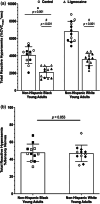Contribution of sensory nerves to cutaneous reactive hyperaemia in non-Hispanic Black and White young adults
- PMID: 37029658
- PMCID: PMC10363287
- DOI: 10.1113/EP091178
Contribution of sensory nerves to cutaneous reactive hyperaemia in non-Hispanic Black and White young adults
Abstract
New findings: What is the central question of this study? Does cutaneous sensory nerve-mediated vasodilatation differ between non-Hispanic Black and White young adults? What is the main finding and its importance? The magnitude of cutaneous reactive hyperaemia is lower in non-Hispanic Black relative to non-Hispanic White young adults, but the overall sensory nerve contribution is the same, suggesting that sensory nerve function is similar in both non-Hispanic Black and White young adults.
Abstract: The aim of this study was to assess cutaneous sensory nerve function, independent of nitric oxide, in non-Hispanic Black and White young adults. We tested the hypothesis that cutaneous reactive hyperaemia and sensory nerve-mediated vasodilatation would be lower in non-Hispanic Black young adults relative to non-Hispanic White young adults. Twenty-four participants who self-identified as non-Hispanic Black (n = 12) or non-Hispanic White (n = 12) were recruited. All participants underwent three bouts of reactive hyperaemia. An index of skin blood flow was measured continuously using laser-Doppler flowmetry at a control site and at a site treated with topical 4% lignocaine to inhibit sensory nerve function. Peak reactive hyperaemia was lower in non-Hispanic Black relative to non-Hispanic White participants (P < 0.001). Total reactive hyperaemia was lower in non-Hispanic Black [mean (SD); control, 4085 (955)%CVCmax s; lignocaine, 2127 (639) percent maximal cutaneous vascular conductance * seconds, %CVCmax s] relative to non-Hispanic White [control: 6820 (1179)%CVCmax s; lignocaine, 3573 (712)%CVCmax s] participants (P < 0.001 for both sites). There was no difference between groups for the calculated contribution of sensory nerves to either the peak [non-Hispanic Black, 25 (14)%; non-Hispanic White, 19 (13)%] or total reactive hyperaemic response [non-Hispanic Black, 48 (10)%; non-Hispanic White, 47 (10)%]. These data suggest that cutaneous reactive hyperaemia is lower in non-Hispanic Black young adults, but the sensory nerve contribution is similar in non-Hispanic Black and White young adults.
Keywords: arterial occlusion; human; microvascular function.
© 2023 The Authors. Experimental Physiology published by John Wiley & Sons Ltd on behalf of The Physiological Society.
Conflict of interest statement
None declared.
Figures


Similar articles
-
Sensory nerve-mediated and nitric oxide-dependent cutaneous vasodilation in normotensive and prehypertensive non-Hispanic blacks and whites.Am J Physiol Heart Circ Physiol. 2020 Aug 1;319(2):H271-H281. doi: 10.1152/ajpheart.00177.2020. Epub 2020 Jun 19. Am J Physiol Heart Circ Physiol. 2020. PMID: 32559139 Free PMC article.
-
Transient receptor potential vanilloid type-1 (TRPV-1) channels contribute to cutaneous thermal hyperaemia in humans.J Physiol. 2010 Nov 1;588(Pt 21):4317-26. doi: 10.1113/jphysiol.2010.195511. J Physiol. 2010. PMID: 20807792 Free PMC article. Clinical Trial.
-
The effect of repeated bouts of hyperaemia on sensory nerve-mediated cutaneous vasodilatation in humans.Microvasc Res. 2018 Sep;119:22-28. doi: 10.1016/j.mvr.2018.04.002. Epub 2018 Apr 7. Microvasc Res. 2018. PMID: 29634957
-
Human cutaneous reactive hyperaemia: role of BKCa channels and sensory nerves.J Physiol. 2007 Nov 15;585(Pt 1):295-303. doi: 10.1113/jphysiol.2007.143867. Epub 2007 Sep 27. J Physiol. 2007. PMID: 17901123 Free PMC article.
-
Cutaneous reactive hyperaemia is unaltered by dietary nitrate supplementation in healthy humans.Clin Physiol Funct Imaging. 2018 Sep;38(5):772-778. doi: 10.1111/cpf.12478. Epub 2017 Oct 29. Clin Physiol Funct Imaging. 2018. PMID: 29082595 Clinical Trial.
Cited by
-
The effect of acute hot water immersion on cutaneous peripheral microvascular responses in males of White-European, Black-African and South-Asian descent.Temperature (Austin). 2025 Jan 24;12(2):149-165. doi: 10.1080/23328940.2025.2453959. eCollection 2025. Temperature (Austin). 2025. PMID: 40330612 Free PMC article.
-
The effect of endothelin a receptor inhibition and biological sex on cutaneous microvascular function in non-Hispanic Black and White young adults.Physiol Rep. 2024 Jul;12(14):e16149. doi: 10.14814/phy2.16149. Physiol Rep. 2024. PMID: 39016164 Free PMC article.
References
-
- Al Kibria, G. , Nemirovsky, A. , Sharmeen, A. , & Day, B. (2019). Age‐stratified prevalence, treatment status, and associated factors of hypertension among US adults following application of the 2017 ACC/AHA guideline. Hypertension Research, 42(10), 1631–1643. - PubMed
-
- Binggeli, C. , Spieker, L. E. , Corti, R. , Sudano, I. , Stojanovic, V. , Hayoz, D. , Luscher, T. F. , & Noll, G. (2003). Statins enhance postischemic hyperemia in the skin circulation of hypercholesterolemic patients: A monitoring test of endothelial dysfunction for clinical practice? Journal of the American College of Cardiology, 42(1), 71–77. - PubMed
-
- Cameron, N. E. , Eaton, S. E. M. , Cotter, M. A. , & Tesfaye, S. (2001). Vascular factors and metabolic interactions in the pathogenesis of diabetic neuropathy. Diabetologia, 44(11), 1973–1988. - PubMed
Publication types
MeSH terms
Substances
Grants and funding
LinkOut - more resources
Full Text Sources

